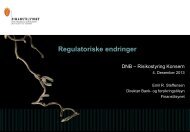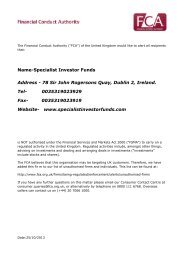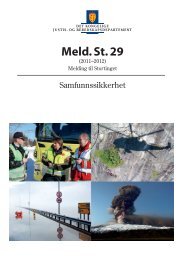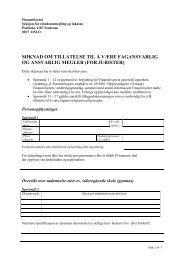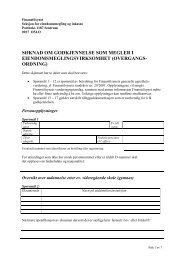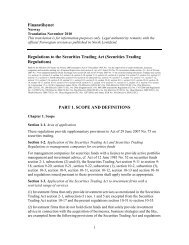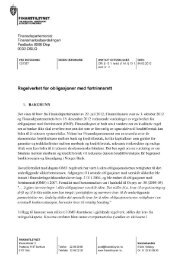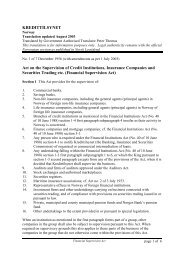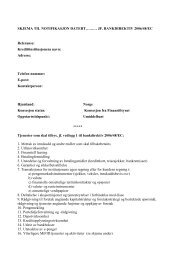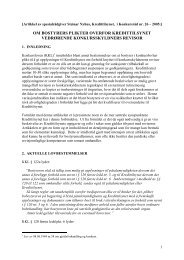View - Esma - Europa
View - Esma - Europa
View - Esma - Europa
You also want an ePaper? Increase the reach of your titles
YUMPU automatically turns print PDFs into web optimized ePapers that Google loves.
Report<br />
13 th Extract from the EECS’s Database of Enforcement<br />
3 April 2013 | ESMA/2013/ 444
Table of Contents<br />
Introduction ____________________________________________________________ 3<br />
I Decision ref EECS/0113-01 – Recognition of financial expense on financial liabilities measured at<br />
amortised cost __________________________________________________________ 4<br />
II Decision ref EECS/0113-02 – Intangible assets with indefinite useful life __________________ 6<br />
III Decision ref EECS/0113-03 – Presentation of revenue and expenses related to service concession<br />
arrangements ___________________________________________________________ 7<br />
IV Decision ref EECS/0113-04 – Value in use calculation _______________________________ 9<br />
V Decision ref EECS/0113-05 – Assessment of materiality of an error _____________________ 10<br />
VI Decision ref EECS/0113-06 – Related party disclosures in interim financial statements ________ 12<br />
VII Decision ref EECS/0113-07 – Definition of a business _______________________________ 13<br />
VIII Decision ref EECS/0113-08 – Disclosures related to fair value of financial instruments ________ 15<br />
IX Decision ref EECS/0113-09 – Discount rate in value in use calculation ___________________ 17<br />
X Decision ref EECS/0113-10 – Residual value of property _____________________________ 19<br />
List of abbreviations and acronyms used in this report<br />
CAPM Capital Asset Pricing Model<br />
CGU Cash-generating Unit<br />
EEA European Economic Area<br />
EECS European Enforcers Coordination Sessions<br />
EU European Union<br />
IAS International Accounting Standard<br />
IASB International Accounting Standards Board<br />
IFRS International Financial Reporting Standard<br />
IFRS IC International Financial Reporting Standards Interpretation Committee<br />
WACC Weighted Average Cost of Capital<br />
Date: 3 April 2013<br />
ESMA/2013/444<br />
ESMA • CS 60747 – 103 rue de Grenelle • 75345 Paris Cedex 07 • France • Tel. +33 (0) 1 58 36 43 21 • www.esma.europa.eu
Introduction<br />
The European Securities and Markets Authority (ESMA) is publishing extracts from its confidential database<br />
of enforcement decisions on financial statements by individual European enforcers, with the aim of providing<br />
issuers and users of financial statements with relevant information on the appropriate application of the<br />
International Financial Reporting Standards (IFRS).<br />
According to European Regulation no 1095/2010 establishing ESMA, ESMA shall act in the field of financial<br />
reporting, to ensure the effective and consistent application of European Securities and Markets legislation.<br />
Those responsibilities are organised by ESMA through European Enforcers Coordination Sessions (EECS), a<br />
forum containing 37 European enforcers from 29 countries in the European Economic Areas (EEA).<br />
The European national enforcers monitor and review financial statements published by issuers with securities<br />
traded on a regulated market who prepare their financial statements in accordance with International<br />
Financial Reporting Standards (IFRS) and consider whether they comply with IFRS and other applicable<br />
reporting requirements, including relevant national law.<br />
Operating under ESMA, EECS is a forum that promotes a high level of harmonisation in the application of<br />
IFRS and consistency amongst enforcers in decision taken when reviewing the IFRS financial statements. A<br />
key function of EECS is the analysis and discussion of decisions taken, or to be taken, by national enforcers in<br />
respect of IFRS financial statements. According to the ESMA Regulation, new legal instruments, such as<br />
opinions can be used to achieve consistency in enforcement.<br />
In taking enforcement decisions, European national enforcers apply their judgement, knowledge and<br />
experience to the particular circumstances of the cases that they consider. Relevant factors may include other<br />
areas of national law beyond the accounting requirements. Interested parties should therefore consider<br />
carefully the individual circumstances when reading the cases. As IFRS are principles based, there can be no<br />
one particular way of dealing with numerous situations which may seem similar but in substance are different.<br />
Consistent application of IFRS means consistent with the principles and treatments permitted by the<br />
standards.<br />
Decisions taken by enforcers do not provide generally applicable interpretations of IFRS, which remains the<br />
role of the IFRS Interpretations Committee (IFRS IC).<br />
ESMA has developed a confidential database of enforcement decisions taken by individual European enforcers<br />
as a source of information to foster appropriate application of IFRS. ESMA is committed to publish extracts of<br />
the database to provide issuers and users of financial statements with similar assistance.<br />
Publication of enforcement decisions will inform market participants about which accounting treatments<br />
European national enforcers may consider as complying with IFRS; that is, whether the treatments are<br />
considered as being within the accepted range of those permitted by IFRS. Such publication, together with the<br />
rationale behind these decisions, will contribute to a consistent application of IFRS in the EEA.<br />
Decisions that deal with simple or obvious accounting matters are normally not published, even if they related<br />
to material breaches leading to sanctions. The selection criteria are based on the above stated objectives, and<br />
accordingly, only decisions providing market participants with useful guidance will be published.<br />
On this basis, all cases submitted to the enforcement database are considered as appropriate for publication,<br />
unless:<br />
• similar decisions have already been published by ESMA, and publication of a new one would not add<br />
any substantial value to the fostering of consistent application;<br />
• the decision deals with a simple accounting issue that, even having been considered a material<br />
infringement, does not in itself have any accounting merit;<br />
• there is no agreement between European enforcers to support the submitted decision; and<br />
• a particular European national enforcer, on a grounded and justified basis, believes that the decision<br />
should not be published.<br />
ESMA will continue publishing further extracts from the database on a regular basis.<br />
3
I Decision ref EECS/0113-01 – Recognition of financial expense on financial liabilities<br />
measured at amortised cost<br />
Financial year end: 31 December 2010<br />
Category of issue: Recognition of financial expense on financial liabilities measured at amortised cost<br />
Standards or requirements involved: IAS 39 - Financial Instruments: Recognition and Measurement<br />
Date decision taken: January 2012<br />
Description of the issuer’s accounting treatment<br />
1. The issuer operates in the real estate industry. Its main activities are: construction in the residential sector,<br />
buying and selling of land and buildings, leasing of real estate and operation of hotels.<br />
2. In May 2008, the issuer refinanced a significant amount of its debt, which consisted of a syndicated loan<br />
and other credit facilities. The final maturity of this debt was February 2011, subject to compliance with<br />
certain covenants. In July 2008, subsequent to breaking these covenants, the issuer agreed to file for<br />
receivership. Under the applicable law, when in receivership, the management of the issuer can continue to<br />
manage the normal tasks of the business with the authorization of the administrator named by the Court.<br />
3. In March 2011, a judge approved an ‘Agreement of Creditors’, thus allowing the issuer to exit the<br />
receivership. The Agreement of Creditors gave the creditors the choice between two alternatives:<br />
• 70% nominal debt reduction with maturity of the revised principal in the form of five annual<br />
payments: 0.5% in each of 2011 and 2012, 1% in 2013, 23% in 2014 and 75% in 2015; or<br />
• no nominal debt relief. The maturity of the loan would be extended to eight years with an interest<br />
rate of Euribor + 0.5%, payable retrospectively from the date of filing for receivership (July 2008).<br />
The second alternative was accepted by a 76% of creditors.<br />
4. In its 2010 IFRS annual financial statements, the issuer did not recognise any financial expense for the<br />
financial liabilities. The issuer argued that, because bankruptcy law had suspended the accrual of interest<br />
during the period of receivership and the Agreement of Creditors had not been approved by the court at the<br />
date of issuance of the financial statements, there was uncertainty about the amount of expense to be<br />
recognised.<br />
5. Once the Agreement of Creditors was approved by the court in March 2011, the issuer assessed whether the<br />
terms of the new debt, according to the Agreement of Creditors, were substantially different from the old<br />
debt. The issuer considered that the conditions of the new debt differed substantially from those of the old<br />
debt and recognised the difference between the book value of the old debt and fair value of the new debt in<br />
the statement of comprehensive income. Effectively, the unrecognised financial expense was subsumed<br />
into this gain on derecognition of the original debt.<br />
The enforcement decision<br />
6. The enforcer found the that the accounting treatment was not in compliance with the requirements of IAS<br />
39 paragraphs 9 and AG 8 related to effective interest rate and asked the issuer to recognise retrospectively<br />
financial expenses amounting to 354 million euro, and to spread them over the years between the filing for<br />
receivership in July 2008 and the court decision in March 2011 as the correction of an error in accordance<br />
with paragraph 42 of IAS 8 – Accounting Policies, Changes in Accounting Estimates and Errors.<br />
4
Rationale for the enforcement decision<br />
7. The enforcer considered the legislation suspending the accrual of interest during the period of receivership<br />
to be a legal protection allowing the debtor to re-negotiate its debt arrangements. In addition, this<br />
suspension of accrual might not be permanent as, in situations when the Agreement of Creditors includes<br />
no nominal debt relief, the Court should remove the suspension effective from the date of receivership. The<br />
decision on permanent suspension of interest accrual depends on the content of the Agreement of Creditors<br />
approved by the court. In the case of the issuer, the agreement stipulated retrospective payment of interest<br />
as though the issuer had never applied for receivership.<br />
8. In addition, the enforcer concluded that the bankruptcy law did not affect the accounting treatment and<br />
application of the measurement basis after initial recognition, i.e. amortised cost using the original effective<br />
interest rate continued to be appropriate. The fact that the issuer was experiencing financial difficulties that<br />
created uncertainty about its ability to fulfil its obligations in full should not interrupt the application of the<br />
measurement basis of the financial liability after initial recognition to the extent that the entity continues to<br />
be a going concern. Therefore, the enforcer concluded that the issuer should have continued applying the<br />
amortised cost method recognising financial expenses under the original effective interest rate.<br />
5
II Decision ref EECS/0113-02 – Intangible assets with indefinite useful life<br />
Financial year end: 31 December 2011<br />
Category of issue: Intangible assets with indefinite useful life<br />
Standards or requirements involved: IAS 38 - Intangible Assets<br />
Date decision taken: May 2012<br />
Description of the issuer’s accounting treatment<br />
9. The issuer is a listed company specialising in the distribution of photographic products and services. The<br />
issuer’s statement of financial position included an intangible asset described as an “externally acquired<br />
customer relationship”, which represented 7 % of total assets.<br />
10. The issuer changed its assessment of the useful life of this intangible asset from ‘finite’ to ‘indefinite’. The<br />
issuer argued that IAS 38 paragraph 88 requires an intangible asset to be considered as having an<br />
indefinite useful life when, based on an analysis of all of the relevant factors, there is no foreseeable limit to<br />
the period over which the asset is expected to generate net cash inflows for the entity. The issuer<br />
understood the lack of a foreseeable limit to mean the lack of a ‘predictable limit’. According to this view,<br />
the fact that there is no precisely determinable limit would suffice for the assessment of an intangible asset<br />
as having indefinite useful life.<br />
11. The issuer considered that an intangible asset has an indefinite useful life when it is impossible to foresee<br />
the period of its useful life and it argued that due to a number of factors (e.g., technological evolution,<br />
changing consumer behaviour), it had become impossible to foresee the useful life of the relationship with<br />
a consumer. In support of its argument, the issuer referred to IAS 38 paragraph 91 that states that the term<br />
‘indefinite’ does not mean ‘infinite’.<br />
The enforcement decision<br />
12. The enforcer found that the change in the assessment of the useful life of the externally acquired customer<br />
relationship from ‘finite’ to ‘indefinite’ did not comply with the requirements of IAS 38.<br />
Rationale for the enforcement decision<br />
13. Under IAS 38, an intangible asset has an indefinite useful life only if there is no ‘foreseeable’ limit (i.e.<br />
expected limit) to its useful life as e.g. in case of a brand name or a customer relationship with a corporate<br />
entity. In the case of the issuer, the customer relationship was with individuals and therefore there is by<br />
definition a time limit (namely the death of the customer).<br />
14. IAS 38 paragraph BC 65(a) states that difficulties in accurately determining an intangible asset’s useful life<br />
do not provide a basis for regarding that useful life as indefinite. IAS 38 paragraph BC 62 specifies that for<br />
intangible assets based on ‘legal rights’, where the cash flows are expected to continue for a finite period,<br />
the useful life of the asset is limited to that period, whereas if the cash flows are expected to continue<br />
indefinitely, the useful life is indefinite.<br />
15. The concept of indefinite not meaning infinite life, explained by IAS 38 paragraph 91, refers to the fact that<br />
for intangible assets with an indefinite useful life, maintenance costs are necessary in order that cash<br />
inflows may continue for an unlimited period of time. For example, brand names do not have an infinite<br />
useful life if no investment is made in them. This argument did not apply to the circumstances of the case.<br />
6
III Decision ref EECS/0113-03 – Presentation of revenue and expenses related to service<br />
concession arrangements<br />
Financial year end: 31 December 2010<br />
Category of issue: Service concession arrangements<br />
Standards or requirements involved: IFRIC 12 - Service Concession Arrangements<br />
Date decision taken: November 2011<br />
Description of the issuer’s accounting treatment<br />
16. The issuer is the parent company of a group engaged in infrastructure management (under a service<br />
concession arrangement in the scope of IFRIC 12) that operates in five sectors: motorway concessions,<br />
telecommunications, airports, car parking and logistics facilities. Its main business operations are:<br />
construction, maintenance and operation of motorways, and the management of motorway concessions (as<br />
an operator of public-to-private service concession arrangements).<br />
17. In its 2010 consolidated IFRS financial statements, the issuer applied different accounting policies to the<br />
contractual rights received by the operator of service concession arrangements as consideration for<br />
providing construction or upgrade services, depending on the nature of those rights. These rights were<br />
recognised as either additions to the intangible assets or receivables recognised in the statement of<br />
financial position (depending on the policy applied). The issuer did not account for an expense in the<br />
statement of comprehensive income in relation to the construction services rendered.<br />
18. The issuer justified its accounting policy stating that the construction of the infrastructure was done by a<br />
third party (a building contractor) that constructed it on its behalf, following its instructions. Since the<br />
issuer did not construct the infrastructure itself, it considered that IAS 11 - Construction contracts was not<br />
applicable and the acquisition of the asset should be recorded as any other asset acquisition, without any<br />
effect on the statement of comprehensive income. Revenue and expenses related to the construction were<br />
not recognised as the issuer did not assume the risks and benefits associated with the construction.<br />
19. The issuer referred to the local GAAP applicable to concession arrangements to support its accounting<br />
policy.<br />
The enforcement decision<br />
20. The enforcer concluded that, when applying IFRIC 12, revenue should not be offset against construction<br />
costs in the statement of comprehensive income either when the issuer constructs the asset on its own<br />
account or using a contractor. Consequently, the enforcer required the issuer to record separately the<br />
revenue and the construction or upgrade costs in accordance with IAS 11 and to correct its financial<br />
statements according to IAS 8 paragraph 19.<br />
Rationale for the enforcement decision<br />
21. Based on IFRIC 12 paragraph 14, an operator shall account for revenue and costs relating to construction or<br />
upgrade services in accordance with IAS 11. IFRIC 12 paragraph BC34 refers to situations when total<br />
revenue does not equal total cash inflows and explains that the reason for this outcome is that, when the<br />
operator receives an intangible asset in exchange for its construction services, there are two sets of inflows<br />
and outflows rather than one. In the first set, the construction services are exchanged for the intangible<br />
asset in a barter transaction with the grantor. In the second set, the intangible asset received from the<br />
grantor is used up to generate cash flows from users of the public service.<br />
7
22. The enforcer concluded that the issuer accounting policy could only be accepted if the issuer had carried<br />
out this activity as an agent and not as a principal, as defined in IAS 18 - Revenue. From the specific facts<br />
and circumstances the enforcer established that that the issuer did not act as an agent. Even though the<br />
issuer did not construct the infrastructure directly, but outsourced it to a third party, the building<br />
contractor constructed it on behalf of the issuer and under its instructions. The issuer was exposed to<br />
significant risks and benefits derived from the construction and was liable for the fulfilment of all technical<br />
criteria, terms and conditions specified in the concession service agreement.<br />
8
IV Decision ref EECS/0113-04 – Value in use calculation<br />
Financial year end: 31 December 2011<br />
Category of issue: Value in use calculation<br />
Standards or requirements involved: IAS 36 – Impairment of Assets<br />
Date decision taken: June 2012<br />
Description of the issuer’s accounting treatment<br />
23. The issuer recognised in its statement of financial position a significant amount of goodwill exceeding<br />
100% of its equity. For the purposes of the impairment test of goodwill, the issuer identified six CGUs.<br />
24. The recoverable amount of each CGU was determined based on its value in use by applying the discounted<br />
cash flow method. When determining the cash flow estimates for the CGUs, costs related directly to the<br />
CGUs and a portion of issuer’s sales, general and administration costs (i.e. indirect corporate costs) were<br />
included. The cash flows did not include the following in the indirect corporate costs: the Costs of Sales<br />
Director, Human Resources Director, Chief Financial Officer and Chief Information Officer. The issuer<br />
believed that these costs of corporate officers should not be allocated to the CGUs. This is on the basis that<br />
the independency of cash flows was an important criterion when determining the cash inflows and outflows<br />
of a CGU, and these cash flows benefited the company as a whole rather than the individual CGUs.<br />
25. The unallocated corporate costs represented costs that were needed for corporate level optimisation but not<br />
to improve the performance of the individual CGUs. For example, if a CGU was sold, the costs of these<br />
corporate officers would not be taken into account when determining the sale price but would remain with<br />
the issuer after the sale.<br />
The enforcement decision<br />
26. The enforcer concluded that excluding certain corporate costs from the costs allocated to CGUs did not<br />
comply with requirements of IAS 36 and that all cash outflows had to be included in the cash flows<br />
forecasts.<br />
Rationale for the enforcement decision<br />
27. The enforcer concluded that the corporate costs were cash outflows that, according to IAS 36 paragraph<br />
39(b), were necessarily incurred to generate the cash inflows from continuing use of the assets and could be<br />
allocated on a reasonable and consistent basis to the asset. In addition, in its internal management reports,<br />
the issuer had allocated all costs (including the costs of corporate officers) to CGUs.<br />
28. As the goodwill and other intangible and tangible assets were fully allocated to CGUs, and all estimated<br />
cash inflows were included in the cash flows projections, it was not reasonable to exclude from the CGU’s<br />
estimated cash flows any corporate level costs.<br />
29. The guidance in IAS 36 paragraph 45(b) was not applicable in these circumstances as it referred to<br />
situations where the performance of tangible or intangible assets was enhanced. Additionally, the<br />
independency of cash flows according to definition in IAS 36 paragraph 6 and as further explained in IAS<br />
36 paragraphs 68-69 referred to cash inflows and not to cash outflows as referred to by the issuer.<br />
9
V Decision ref EECS/0113-05 – Assessment of materiality of an error<br />
Financial year end: 31 December 2010<br />
Category of issue: Materiality, correction of an error<br />
Standards or requirements involved: IAS 8 – Accounting Policies, Changes in Accounting Estimates and<br />
Errors, IAS 40 – Investment Property<br />
Date decision taken: December 2011<br />
Description of the issuer’s accounting treatment<br />
30. The issuer is a financial institution that provides banking services, including granting loans and advising in<br />
investment activities, to private, corporate and public sector customers. The issuer owned several<br />
properties classified as investment properties. According to the issuer's accounting policy, investment<br />
property is measured using the cost model, as allowed by IAS 40. The book value of the investment<br />
property in the 2010 annual financial statements was 2.2 million euro.<br />
31. The notes to the IFRS financial statements explained that a professional valuer had estimated the fair value<br />
of one of the investment properties as being 0.8 million euro higher than its book value. Contrary to its<br />
accounting policy, the issuer recognised this amount as a revaluation gain through its statement of<br />
comprehensive income in 2010. The issuer did not indicate any voluntary change in the accounting policy<br />
and did not revalue any other investment property in its portfolio. The issuer's net loss after tax for the year<br />
2010 was 1.6 million euro, including the revaluation of the investment property. The effect of the<br />
revaluation, net of tax, was 0.6 million euro.<br />
32. The issuer argued that the revalued investment property was supposed to be sold during 2010 but the sale<br />
had been postponed. Finally, the sale was finalised in late 2011, with the price being the book value of the<br />
investment property plus 0.8 million euro. The issuer argued that the gain on revaluation of the investment<br />
property was immaterial to its financial statements.<br />
33. The auditor, in its audit review memorandum, had noted that the revaluation was not in compliance with<br />
the accounting policy of the issuer but concluded that the error was not material. The issuer did not<br />
consider the error material because, amongst other things, it would not have had a material impact on<br />
equity.<br />
The enforcement decision<br />
34. The enforcer concluded that the revaluation of one investment property was not in accordance with the<br />
requirements of IAS 40 and that the revaluation constituted a material error in the financial statements.<br />
Consequently, the enforcer asked the issuer to retrospectively correct the error in its 2011 financial<br />
statements.<br />
35. The enforcer pointed out that IAS 8 paragraph 42 requires an entity to correct material prior period errors<br />
retrospectively in the first set of financial statements authorised for issue after their discovery and IAS 8<br />
paragraph 49 requires specific disclosures of prior period errors.<br />
Rationale for the enforcement decision<br />
36. The accounting policy for measurement of investment properties was the cost model. As the issuer did not<br />
change its accounting policy to the fair value model, and other investment properties were not revalued, the<br />
enforcer concluded that the revaluation of the investment property was not performed in accordance with<br />
requirements of IAS 40.<br />
10
37. The enforcer was of the view that the amount recognised for the revaluation of the investment property led<br />
to a material error in the 2010 annual financial statements. The enforcer noted that the reported net loss<br />
for the period of 1.6 million euro would have amounted to a loss of 2.2 million euro without the revaluation<br />
and considered this difference to be material.<br />
11
VI Decision ref EECS/0113-06 – Related party disclosures in interim financial statements<br />
Financial year end: 31 March 2011<br />
Category of issue: Related party disclosures in interim financial statements.<br />
Standards or requirements involved: IAS 24 – Related Party Disclosures, IAS 34 – Interim Financial<br />
Reporting<br />
Date decision taken: September 2011<br />
Description of the issuer’s accounting treatment<br />
38. The issuer manufactures industrial metals. One major shareholder owned 64% of its shares. The ‘other<br />
financial assets’ balance increased significantly during the first quarter of 2011 and totalled 17% of equity,<br />
however the issuer provided no explanation about the change in other financial assets in its interim<br />
financial statements as at 31 March 2011.<br />
39. Other financial assets included the shares of company B, which were bought in January 2011. The<br />
transaction resulted from a decision by the issuer’s board of directors to invest excess cash in shares. At the<br />
same time it was decided that the issuer would enter into an option contract with its major shareholder,<br />
who was also the chairman of the board of directors, allowing the issuer to sell the shares of company B for<br />
the same price as it had bought them in January 2011. This provided protection against the risk of the share<br />
price subsequently decreasing.<br />
40. The option contract stated that the issuer could sell company B’s shares to its major shareholder at any<br />
time it chose during the contract term, until the end of April 2011. As the price of shares of company B<br />
decreased during spring 2011, the issuer decided to sell these shares to its major shareholder based on the<br />
option contract. The sale took place on 13 April 2011 at a price considerably higher than the market price at<br />
the date of the sale. As the shares were sold at the same price as they were bought, the transaction had no<br />
impact on the net profit of the issuer. The issuer did not include any related party disclosures in its March<br />
2011 interim financial statements.<br />
The enforcement decision<br />
41. The enforcer considered that the issuer’s lack of disclosure of material changes in other financial assets and<br />
of the option contract with its biggest shareholder in its March 2011 interim financial statements was not in<br />
compliance with IAS 34 paragraph 15B and IAS 24 paragraphs 18 and 19.<br />
Rationale for the enforcement decision<br />
42. IAS 34 paragraph 15B (h, j and l) requires disclosure of the changes in the business or economic<br />
circumstances that affect the fair value of an entity`s financial assets and financial liabilities, related party<br />
transactions and changes in classification of financial assets as a result of a change in the purpose or use of<br />
those assets.<br />
43. IAS 24 paragraphs 18 and 19 require disclosure of the nature of related party relationships as well as<br />
information about transactions and outstanding balances, including commitments, necessary for users to<br />
understand the potential effect of the relationship on financial statements.<br />
12
VII Decision ref EECS/0113-07 – Definition of a business<br />
Financial year end: 31 December 2010<br />
Category of issue: Definition of a business<br />
Standards or requirements involved: IFRS 3 – Business combinations<br />
Date decision taken: March 2012<br />
Description of the issuer’s accounting treatment<br />
44. The issuer operates in the shipping industry and owns vessels for transportation of cars and other rolling<br />
cargoes. In June 2010 the issuer acquired all the shares in Company B from Company A. Company B<br />
owned all the shipping industry investments of Company A. These investments consisted of shares in<br />
holding companies (Entities C1 – C4, owned 100% by Company B) that owned shares in single purpose<br />
companies (Entities D1 – D4, owned by C1 - C4 respectively, with different ownership percentages). The<br />
single purpose companies each owned and operated one or two shipping vessels.<br />
45. There were no employees in Company B or its subsidiaries. At the acquisition date, there were only limited<br />
activities related to managing the respective companies; other activities were outsourced. All the employees<br />
in Company A were employed by a management company that was a sister company of Company B and was<br />
not part of the transaction (‘management company’). The management company was a matrix organization<br />
where the employees handled several investments areas. Three employees in the management company<br />
were offered and accepted employment in the issuer as part of the transaction.<br />
46. The companies owning the vessels (D1 - D4) had an agreement with the management company concerning<br />
assistance with chartering and purchase and sale of vessels. The management company used a shipbroker<br />
to assist the company with: marketing of the vessels, entering into new charter agreements and serving<br />
customers. The broker assisted in purchases and sales of the vessels. Technical management was<br />
outsourced from the vessel owning entities to the management company until autumn 2009 and<br />
subsequently outsourced to an independent third party company.<br />
47. The issuer accounted for the transaction as an asset acquisition. The consideration paid and related<br />
transaction costs were recognised as the acquisition price of the vessels.<br />
48. The issuer argued that the vessels were only passive investments and that Company B did not own a<br />
business consisting of processes, since all activities regarding commercial and technical management were<br />
outsourced to either the management company or to an independent third party company. Consequently,<br />
the acquisition was accounted for as if the vessels were acquired on a stand-alone basis.<br />
The enforcement decision<br />
49. The enforcer considered that accounting for the transaction as an asset acquisition did not comply with the<br />
requirements of IFRS 3 and required the issuer to account for the transaction as a business combination.<br />
As a result, transaction costs were expensed, the vessels were recognised at fair value, deferred tax was<br />
recognised at nominal value and the difference between these amounts and the consideration paid was<br />
recognised as goodwill.<br />
Rationale for the enforcement decision<br />
50. In accordance with IFRS 3 paragraph 3, an entity shall determine whether a transaction or other event is a<br />
business combination by applying the definition of a business in IFRS 3. A business is defined in Appendix<br />
A as an integrated set of activities and assets that is capable of being conducted and managed for the<br />
13
purpose of providing a return in the form of dividends, lower costs or other economic benefits directly to<br />
investors or other owners, members or participants. Further guidance on the definition of business is given<br />
in IFRS 3 paragraph B7, which states that a business consists of inputs and processes applied to those<br />
inputs that have the ability to create outputs.<br />
51. When analysing the transaction the following elements were considered relevant by the enforcers:<br />
• Inputs: Shares in four vessel owning companies, charter agreements, agreement about outsourcing,<br />
relationship with a shipping broker and customer relations.<br />
• Processes: Activities regarding chartering and operations of the vessels, financing, liquidity<br />
management and interest rate risk management as well as purchase and sales of vessels.<br />
• Outputs: Company B generated profit from charter agreements. It also had the ability to get<br />
economic benefits from the vessels and the established processes for entering into new contracts.<br />
52. IFRS 3 Appendix B11 states that whether a seller operated a set of assets and activities as a business or<br />
whether the acquirer intends to operate it as a business is not relevant in evaluating whether a particular<br />
set is a business. Accordingly, it was not relevant that the seller had outsourced some activities (e.g.<br />
management services for which fees were paid) to a third party as a market participant could chose to<br />
conduct and manage the integrated set of assets and activities as a business. Consequently, the acquisition<br />
included all the elements that constitute a business, in accordance with IFRS3.<br />
14
VIII Decision ref EECS/0113-08 – Disclosures related to fair value of financial instruments<br />
Financial year end: 31 December 2009<br />
Category of issue: Fair value disclosures<br />
Standards or requirements involved: IFRS 7 – Financial Instruments: Disclosures; IAS 39 – Financial<br />
Instruments: Recognition and Measurement<br />
Date decision taken: May 2011<br />
Description of the issuer’s accounting treatment<br />
53. The issuer is a holding company that carries out banking activities through a subsidiary. In 2010, the<br />
prudential regulator withdrew the banking license of the subsidiary for breaches of the banking regulations,<br />
especially regarding: risk management procedures in its trading activities, valuation of the derivatives and<br />
consequent failures to correctly calculate and report the capital requirements of the bank.<br />
54. The trading derivatives portfolio of the bank included trading assets of which approximately 80 % were<br />
classified in level 3 of the fair value hierarchy and trading liabilities of which 60 % were classified in level 3.<br />
The issuer claimed that a level 3 valuation was needed as the market for the derivatives (mainly derivatives<br />
on the stock indexes, with various maturities) was inactive. According to the issuer’s accounting policy, a<br />
market is considered active if: more than 50 % of its positions were traded every day, at least three such<br />
days occurred during a week and at least three such weeks had occurred during the last three months.<br />
55. In its 2008 financial statements, the issuer early-applied amendments to IFRS 7 with regards to the fair<br />
value hierarchy.<br />
56. The issuer’s accounting policy was to recognise the difference between the transaction price at initial<br />
recognition and the value according to its internal model in the statement of comprehensive income at<br />
initial recognition (a day one gain/loss). The 2008 financial statements disclosed that these gains/losses<br />
were immaterial. That statement was no longer included in the 2009 financial statements but no<br />
explanation for its removal was disclosed.<br />
The enforcement decision<br />
57. The enforcer concluded that that the issuer did not comply with the IFRS requirements with regards to<br />
usage of level 3 of the fair value hierarchy where market information was available and the failure to<br />
comply with the disclosure requirements of level 3. Additionally, the enforcer found that the issuer did not<br />
comply with the IFRS requirements related to the initial recognition of a day one gain/loss.<br />
Rationale for the enforcement decision<br />
58. IAS 39 paragraph 48A states that the best evidence of fair value is quoted prices in an active market. The<br />
relevant guidance on valuation is found in IAS 39 paragraph AG76, which requires a valuation technique to<br />
incorporate all factors that market participants would consider in setting a price and to be consistent with<br />
accepted economic methodologies for pricing financial instruments. In addition, IAS 39 requires an entity<br />
to calibrate the valuation technique and test it for validity using prices from any observable current market<br />
transactions in the same instrument or based on any available observable market data.<br />
59. IAS 39 paragraph AG 64 states that the best evidence of the fair value of a financial instrument at initial<br />
recognition is the transaction price (i.e. the fair value of the consideration given or received) unless the fair<br />
value of that instrument is evidenced by comparison with other observable current market transactions in<br />
15
the same instrument or based on a valuation technique whose variables include only data from observable<br />
markets.<br />
60. The investigation by the prudential regulator showed that there was market information on the<br />
instruments available for all trading days during 2009 and the first quarter of 2010 and that there were<br />
market transactions for part of the instruments held at times close to the issuers reporting dates. There<br />
were doubts raised about the valuation model used, but the enforcer did not pursue this further as the<br />
availability of market information already clarified that level 3 categorisation was not appropriate.<br />
Consequently, the trading portfolio was materially overstated as at 31 December 2009, relative to a<br />
valuation based on market observable inputs.<br />
61. Although the usage of level 3 was not appropriate in all cases, the issuer classified substantial part of its<br />
portfolio as level 3. As a consequence of using a level 3 fair value, IFRS 7 paragraph 27B requires additional<br />
disclosures that were not provided.<br />
62. IAS 39 paragraph AG76A requires that where no gain or loss is recognised on initial recognition of a<br />
financial instrument, a gain or loss shall be recognised after initial recognition only to the extent that it<br />
arises from a change in a factor (including time) that market participants would consider in setting a price.<br />
63. The issuer argued that the accounting policy regarding the recognition of a day one gain was not in<br />
accordance with IAS 39 as its systems were not capable of calculating the amounts. These arguments were<br />
not accepted by the enforcer.<br />
16
IX Decision ref EECS/0113-09 – Discount rate in value in use calculation<br />
Financial year end: 31 December 2009<br />
Category of issue: Discount rate in value in use calculation<br />
Standards or requirements involved: IAS 36 – Impairment of Assets<br />
Date decision taken: February 2010<br />
Description of the issuer’s accounting treatment<br />
64. The issuer operates in the renewable energy sector and manufactures and sells solar panels. It was in the<br />
process of listing on a regulated market. The prospectus under review included IFRS financial information<br />
for the years 2009, 2008 and 2007.<br />
65. In 2007, the issuer recorded 171 million euro of goodwill as a consequence of the acquisition of the solar<br />
panels´ manufacturing business from another entity. This was the only intangible asset with indefinite<br />
useful life recognised in the statement of financial position.<br />
66. More than 99% of the goodwill was allocated to the manufacturing of solar panels CGU. In its impairment<br />
test, the recoverable amount of the CGU was determined by calculating value in use based on pre-tax cash<br />
flows over a six year period. The issuer disclosed the key assumptions used to determine the value in use:<br />
the operating profit, the terminal growth rate and the post-tax discount rate for each of the periods.<br />
Nonetheless, some data in the value in use calculations (e.g. operating profit) differed from the information<br />
disclosed in the segment note to the financial statements.<br />
67. In determining the discount rate, the issuer calculated the cost of debt as the average of the interest rates<br />
on its outstanding borrowings, but excluded a long-term subordinated loan from the calculation.<br />
68. The issuer disclosed that no goodwill impairment losses had been recognised. The budgeted gross margins<br />
that were disclosed considered the expected market development. The growth rates were consistent with<br />
those forecasted in the industry sector and the discounts rates were determined before tax and reflected<br />
specific risks related to the relevant segments. The issuer disclosed that an increase of 0.5 percentage<br />
points in the discount rate would not lead to recognition of goodwill impairment. Nonetheless, the decrease<br />
in the disclosed discount rate from 2008 to 2009 was larger than the 0.5 percentage points scenario<br />
included in the sensitivity analysis in the 2009 financial statements.<br />
The enforcement decision<br />
69. The enforcer considered that the issuer did not comply with the requirements of IAS 36 and required it to<br />
review the impairment calculations, to record the resulting goodwill impairment and to provide additional<br />
disclosures as required by IAS 36 in its 2009 financial statements.<br />
Rationale for the enforcement decision<br />
70. IAS 36 paragraph 33 requires an entity measuring value in use to base cash flow projections on reasonable<br />
and supportable assumptions that represent management’s best estimate of the range of economic<br />
conditions that will exist over the remaining useful life of the asset on the basis of the most recent financial<br />
budgets approved by management. The entity should exclude any estimated future cash inflows or outflows<br />
expected to arise from future restructurings or from improving or enhancing the asset’s performance.<br />
17
71. The enforcer found that the cash flows used as the basis of the projections (i.e. expectations of future<br />
operating profits) differed significantly from the operating profit before depreciation included in the 2009<br />
and 2008 segment notes to the financial statements. The estimated cash flows before taxes used to<br />
determine the CGU recoverable amounts reported were inadequate because the expectations for operating<br />
profit were not based on the financial budgets approved by the Board of Directors, which covered a 6 year<br />
period. As a consequence, the enforcer found a need for adjustments to the estimated cash-flows used in<br />
the calculation.<br />
72. IAS 36 paragraph 55 requires the discount rate used in impairment testing and disclosed in financial<br />
statements to be a pre-tax rate. Accordingly, the enforcer concluded that the discount rate disclosed for<br />
2009 was not correct, since it disclosed a post-tax rate and not the pre-tax rate that the entity effectively<br />
used in its calculation.<br />
73. IAS 36 paragraphs 55 - 57 require the discount rate to be a pre-tax rate that reflects current market<br />
assessments of the time value of money and the risks specific to the asset for which the future cash flow<br />
estimates have not been adjusted. In particular, the enforcer noted that IAS 36 paragraph A19 requires the<br />
discount rate to be independent of the entity’s capital structure and the way the entity financed the<br />
purchase of the asset.<br />
74. The enforcer did not agree with the cost of debt used by the issuer in the post-tax weighted average cost of<br />
capital (WACC) calculation, since the credit risk spread applied did not reflect current market assessments<br />
of the time value of money and the risks specific to the asset. The enforcer requested the entity to<br />
recalculate its debt rate, considering as a starting point (IAS 36 paragraphs A17 - A19) all new loans entered<br />
into by the issuer in 2009 that reflect the current market assessment of credit risk, as well as the long term<br />
subordinated loan that was originally excluded from the calculation.<br />
18
X Decision ref EECS/0113-10 – Residual value of property<br />
Financial year end: 31 December 2011<br />
Category of issue: Residual value of property<br />
Standards or requirements involved: IAS 16 – Property, Plant and Equipment<br />
Date decision taken: March 2012<br />
Description of the issuer’s accounting treatment<br />
75. The issuer both owns and operates a fleet comprising supply and subsea vessels and provides services to<br />
the subsea market. These vessels constitute a material part of the issuer’s total assets. The economic life of<br />
the vessels is estimated to be 30 years, but the useful life is 20 years since the issuer’s policy is to sell the<br />
vessels when they are 20 years old.<br />
76. The issuer estimated the residual value of the vessels to be to 50 % of acquisition cost. This residual value<br />
was assumed to be constant during the useful life. The issuer observed in its financial statements that a<br />
residual value was an estimate with a high level of uncertainty especially when the realisation was over a<br />
significant period. As the average age of the fleet was six years, the expected realisation would have taken<br />
place, on average, in 14 years.<br />
77. In its correspondence with the enforcer, the issuer explained that the vessel’s valuation, using discounted<br />
cash flows, was calculated based on its acquisition cost and a required rate of return. The required rate of<br />
return, used to discount the cash flows, was fixed through the useful life of the vessel. The calculation<br />
resulted in an estimated market value after 20 years of approximately 65 % of acquisition cost, which<br />
corresponded to cash flows from year 20 to year 30 discounted to the present value in year 20. The<br />
calculation did not allow for inflation.<br />
78. Older vessels have a greater inherent need for maintenance, and significant maintenance is required when<br />
the vessel is between 10 and 20 years old in order for the vessel to have a useful life of 30 years. These<br />
conditions were taken into account in the estimate, by setting the residual value to 50 % of acquisition cost<br />
and not 65 % that resulted from the annuity calculation.<br />
79. The issuer argued that the estimates used are conservative in view of an immature market with a high<br />
degree of uncertainty and presented statistics that documented that newer vessels, built after 2000, were<br />
sold for a price considerably over cost. Consequently, it was difficult to compare today’s vessels with<br />
eventual proceeds for the vessels for in 20 years, since the offshore market had a relatively short operating<br />
history with limited vessel sales.<br />
80. In connection with estimating the residual value, the issuer made a comparison against broker valuations.<br />
If the estimate had been based on broker valuations, the residual value would have been considerably<br />
higher than that calculated using discounted cash flows. The issuer chose not to base its assessment on<br />
broker valuations, since it would result in greater volatility in the financial reporting. The issuer had a longterm<br />
perspective and reflected only changes in long-time trends in changes of residual values.<br />
The enforcement decision<br />
81. The enforcer did not accept the issuer’s calculation of residual amount and concluded that estimating<br />
residual value based on acquisition cost did not comply with the requirements of IAS 16 paragraph 6.<br />
Consequently, the enforcer required the issuer to prepare a new model when determining residual value<br />
that would take account of broker valuations at the end of each reporting period and which would produce<br />
zero depreciation charge when estimated residual value was higher than the carrying amount.<br />
19
Rationale for the enforcement decision<br />
82. IAS 16 paragraph 6 defines residual value as the estimated amount that an entity would currently obtain<br />
from disposal of the asset, after deducting the estimated costs of disposal, if the asset were already at the<br />
age and in the condition expected at the end of its useful life. The definition of residual value implies that<br />
the issuer shall make an estimate of what the vessel could have been sold for today, if the vessel already was<br />
20 years old.<br />
83. IAS 16 paragraph 51 requires the residual value to be reviewed at least at the end of each reporting period.<br />
According to IAS 16 paragraph 50 the depreciable amount of an asset shall be allocated on a systematic<br />
basis over its useful life. IAS 16 paragraph 53 specifies that the depreciable amount of an asset is<br />
determined after deducting its residual value.<br />
84. The issuer’s original model implied that the residual value was constant for the vessel’s entire useful life.<br />
The enforcer noted that the residual value had to be adjusted especially when the expected sale<br />
approached, and residual value had to come closer to disposal proceeds minus disposal costs at the end of<br />
the useful time. This is confirmed in IAS 16 paragraph 54 that notes that in cases when the residual value is<br />
greater than the asset’s carrying amount, the depreciation charge is zero unless and until its residual value<br />
subsequently decreases to an amount below the asset’s carrying amount.<br />
85. The residual value shall be estimated to be the value at the reporting date as if the vessel were already of the<br />
age and in the condition expected at the end of its useful life. According to IAS 16 paragraph BC 29, an<br />
increase in the expected residual value of an asset because of past events will affect the depreciable amount,<br />
while expectation of future changes in residual value other than the effects of expected wear and tear will<br />
not.<br />
86. IAS 16 does not provide guidance how to estimate residual value when the useful time is considered to be<br />
shorter than the economic life. Even though there was considerable uncertainty associated with the<br />
estimate of residual value, especially for newer vessels when there is no vessel in the market, the estimate<br />
for residual value should correspond to market value (after costs of disposal) for similar 20-year old<br />
vessels. When there are no such vessels, residual value had to be estimated from a relevant market value.<br />
87. The issuer did not use broker valuations directly, since it would have given more volatility in the estimates.<br />
The enforcer considered that undesirable volatility was not a convincing argument to support an<br />
accounting treatment, and broker valuations could be a useful starting point to estimate residual value. The<br />
enforcer noted that some vessels older than 10 years had broker values above residual value. This might<br />
have indicated that the residual value was too low, and that the issuer should have stopped depreciation at<br />
an earlier stage.<br />
20



